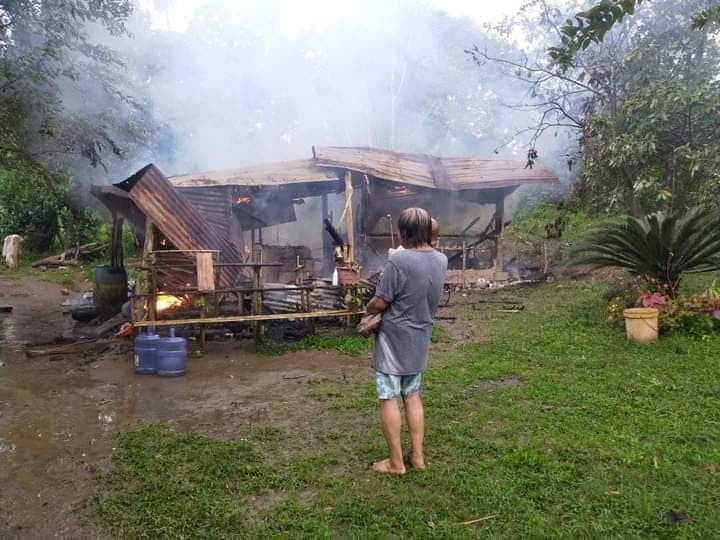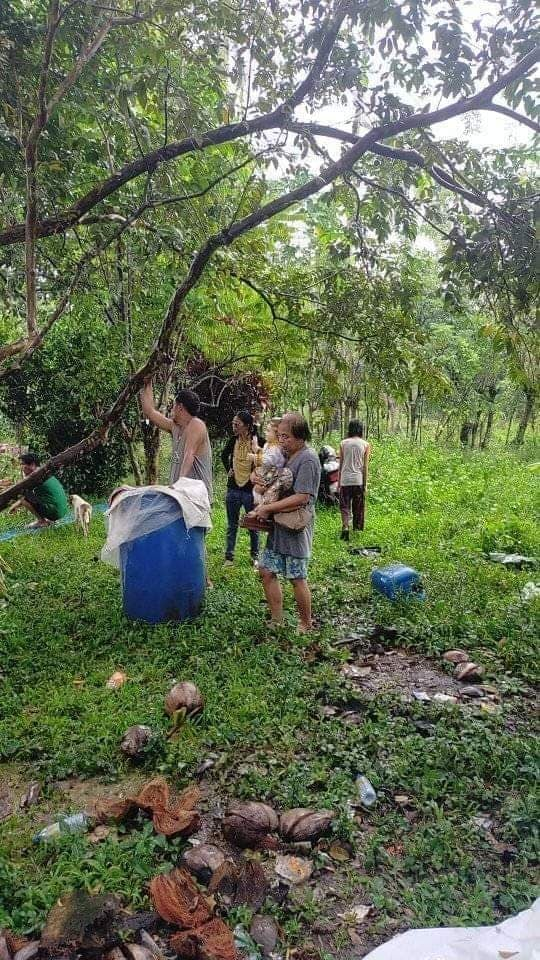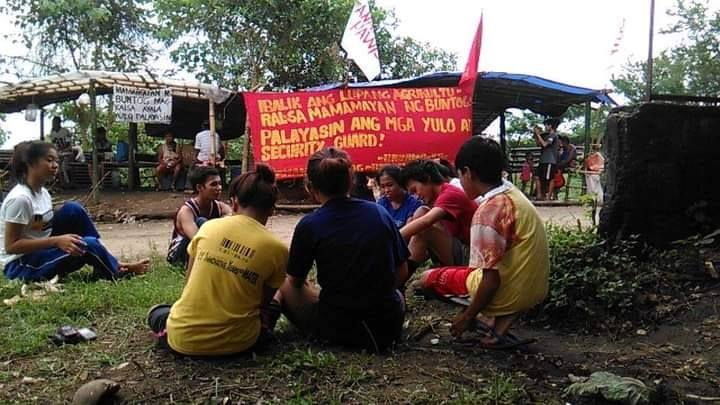
SANTA ROSA, Laguna — Dorotea Mangubat watched silently as her family’s home was being burned down. She could do nothing but clutch a statue of the Sto. Niño; the only possession she managed to salvage from inside. Had the armed guards had their way, Dorotea would’ve burned inside the house with her Sto. Niño statue.
The January 23 arson incident was only another episode in a long month of violence gripping sitio Buntog in barangay Canlubang, Calamba, Laguna. Reports from Buntog read out like a warzone: armed guards employed by Seraph Security have blocked residents like Dorotea from entering or exiting Buntog, turning their community into an internment camp.
Outside Buntog lies Ayala Land’s largest project in the province: the Nuvali Ecozone, a 1,700 hectare residential and commercial development project. Also near are golf courses, industrial parks, upscale subdivisions, and other urban development projects.
All of these make up Hacienda Yulo, a 7,100 hectare anomaly owned by the Yulo clan and, for decades, lorded over like a small kingdom. But far more important is the story of its people.
Small beginnings
Conventional history states that Canlubang came from the word kanlungan, meaning sanctuary, or den. During Spanish colonization, the place, it was said, was a “den of thieves and bandits.” The land was virgin forest, with patches of civilization hugging the rivers and slopes. Farmers planted rice, coconut, and other fruit trees while engaging in trade.
Meanwhile, religious orders passed around ownership of the land before settling on the Dominicans in 1831. The Philippine Revolution would ferment the anti-feudal struggle, but it would be the succeeding period of American colonization that would dislodge the Dominican Order. In 1905, all Spanish titles were rendered invalid and the old lands of the Church became public.
Canlubang remained relatively untouched for some time. On January 30, 1911, Taal volcano erupted and forced farmers from Talisay, Batangas to seek refuge in other provinces. They eventually settled in a patch of forest that is now sitio Buntog and began to work the land, making it productive.
It didn’t take long for American interests to take notice. In 1912, a California-based group called Ehrman Trust obtained titles for large swathes of barangay Canlubang with the intention of entering the sugar business. Sugar was a top Philippine export at the time, and American businessmen saw the potential for increased production and profit from the cheap labor and ample farmland in the country.

Canlubang was a perfect place to create a sugar empire.
Associates working for Ehrman Trust built the country’s second sugar central, a sugar mill surrounded by vast sugarcane fields. Louis Weinzheimer served as General Manager of the Canlubang Sugar Estate while Americans like G. Milne pushed farmers from their farms to make way for sugarcane.
The sugar plantation became the center of farmer life in the area. Residents became farm-workers for the estate, while their children became guards and workers for the sugar mill. The Americans tolerated some tenancy farming in the fringes. In 1927, Ehrman Trust employed a young Jose Miguel Yulo as legal counsel, and eventually, caretaker, or the estate.
The advent of the Second World War and rising nationalist sentiment forced the Americans to take flight. Canlubang was sold to Vicente Madrigal in 1941, who held it until it was sold to Yulo seven years later.
This was far from a random choice: Madrigal acquired a sugar plantation ruined by war and brimming with peasant and labor unrest. Workers formed Bisig ng Canlubang and were clamoring for rights while farmers and farm-workers were emboldened by the idea of land reform. Madrigal found it better to simply sell the land and be done with the trouble.
The birth of a hacienda
Jose Yulo wasted no time maximizing his newly acquired land for sugar production. He coerced farmers to sell their produce to the plantation under threats of violence, while simultaneously acquiring more titles to his hacienda. As more farmers ended up working for Yulo, he expanded operations to include a ranch, and coffee and coconut production.
To curb dissent, Yulo built schools, churches, and other amenities to ingratiate themselves to the farmers, with the intention of creating a “model agro-industrial complex.” His wife, Cecilia Araneta, presided over projects which gave farmers free housing, healthcare, and college scholarships, with the promise of “permanent” housing and retirement benefits.
This would not stop farmers from asking for land reform, however. In 1959, residents of Buntog began a petition for the rights to land. To counter this, in 1961, Yulo coerced and paid farmers to march on Malacañang to stage a picket protest saying that they “lived in a golden cage” and “didn’t want land reform.” Those who didn’t support Yulo, or weren’t swayed by enticements of cash and other gifts, were harassed and eventually evicted.
Yulo used his position in government to sidestep land reform. His closeness to the Marcos dictatorship allowed the Canlubang Sugar Estate to be exempt from Presidential Decree 27, which did not include sugar estates.
Yulo coordinated with the national government’s plan for industrialization, profiting off massive infrastructure projects like the South Superhighway and the establishment of the country’s first industrial zones. This trend continued after Jose Yulo’s death and into the present day, as more parts of the old hacienda were converted from agricultural to industrial and residential zones, while also dodging land reform initiatives.
Hacienda Yulo today
Some sources paint Canlubang as a site of faded glory. The truth could not be farther. Today, five Yulo-owned companies have divvied up the Yulo estate and have coordinated with corporations like Ayala Land, Vista Land, and others, to engage in land-use conversion and urban development. The old farmlands have been converted into golf courses, industrial parks, tourist spots, and recreational centers.

The same is true in sitio Buntog. Ayala Land, through the Yulo-owned San Cristobal Realty Development Corporation, is pushing for the area to be turned into residential housing as part of its Nuvali project. San Cristobal has tried to push this development since 2006, but efforts have been stalled, in no small part to the farmers’ struggle.
This, however, does not stop Ayala-hired “security firms” like Seraph Security Agency from violently harassing the farmers continuing to resist. Since January 6, residents from Buntog have suffered threats, assault, destruction of property, arson, and other acts. Some residents have been forced to flee Buntog, fearing for their lives.
Regardless, Dorotea isn’t afraid to fight. “We don’t have much,” she says. “The only thing we can pass on to our children is our land. We already lost everything else. We have nothing left to lose. Why should we be afraid?” ###